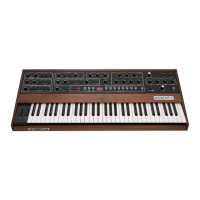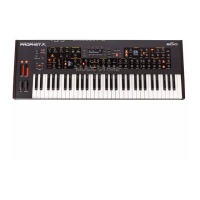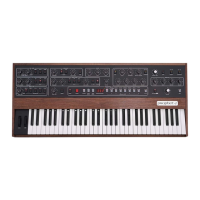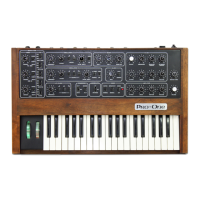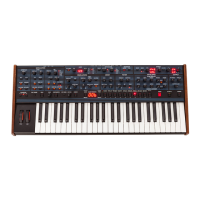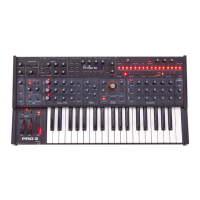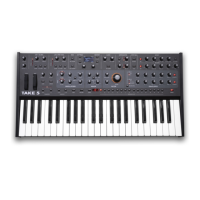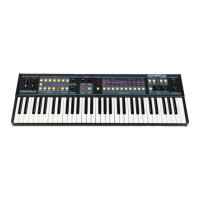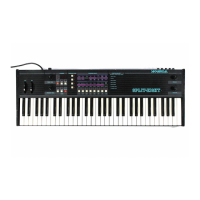Do you have a question about the Sequential Prophet VS and is the answer not in the manual?
Details items included with the Prophet VS.
Guidelines for safely moving and caring for the instrument.
Explains rear panel audio and footswitch connections.
Details MIDI connections and setup.
Setting voltage, fusing, and connecting power for safe operation.
Instructions for adjusting LCD contrast.
How to select programs, adjust master volume, and balance.
Adjusts the overall tuning of the synthesizer for ensemble playing.
Explains keyboard modes, velocity, pressure, and position sensitivity.
Details the function and adjustment of the Pitch and Mod wheels.
Covers waveform mix joystick, chorus, and footswitches.
Overview of the Prophet VS's programming capabilities.
Explains internal and cartridge memory systems (RAM/ROM).
How to enter and use the mode for editing sound parameters.
Procedures for saving, transferring, and naming programs.
Standard mode where up to eight voices play polyphonically.
Keyboard modes for layering or splitting sounds.
Introduction to the arpeggiator's features and operation.
Controls for rate, latching, transposing, and sequence playback.
Settings for modes, scan, repeats, split, voicing, velocity, layer, rests, and clock sync.
Block diagram and explanation of the signal path in a voice.
Details the four oscillators (A, B, C, D) and their function.
Blending oscillators via joystick and dynamic timbre control.
Controls for selecting oscillators, waveforms, and tuning.
Explains the role of the filter in shaping timbre.
Adjusting filter cutoff frequency and resonance.
Setting the depth of the filter envelope modulation.
Introduction to the three ADSR-like envelope generators.
How the mixer envelope controls oscillator blend via the joystick.
Controls for shaping filter response and loudness over time.
Details on Point, Rate, Level, Loop, and Repeat settings for envelopes.
Introduction to the two independent Low-Frequency Oscillators.
Adjusting LFO shape and rate.
Understanding how modulation adds expressiveness to the sound.
Establishing modulation paths by choosing sources and destinations.
Thickening sounds and creating pitch slides between notes.
Positioning voices in stereo and setting program volume.
Explains the chorus effect and its stereo circuits.
Adjusting chorus rate, depth, and enabling left/right circuits.
Overview of creating and storing custom waveforms.
Entering the mode for editing and creating new waveforms.
Adjusting assigned waveforms, their harmonic content, and blend.
Saving newly created waveforms and checking their usage.
Introduction to MIDI, basic connections, and master/slave setups.
Program selections, wheels, MIDI clock, and arpeggiation synchronization.
How the VS uses channels and processes MIDI data based on mode.
Configuring Receive Mode, Wheels, Programs, Pressure, Joystick, and Parameters.
Procedures for data dumps and technical MIDI message details.
Overview of factory programs and waveform descriptions.
A comprehensive list of all factory programs.
Detailed explanations for selected factory programs.
Blank forms for documenting custom program settings.
| Type | Digital Vector Synthesizer |
|---|---|
| Polyphony | 8 voices |
| Filter | Curtis CEM3379 4-pole Low-pass Filter |
| LFO | 1 LFO with multiple waveforms |
| Keyboard | 61 keys |
| Synthesis Type | Vector synthesis |
| Memory | 100 patches |
| Control | MIDI |
| Year Released | 1986 |
| Oscillators | 4 digital oscillators |
| Outputs | Stereo outputs |
